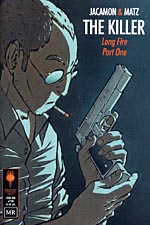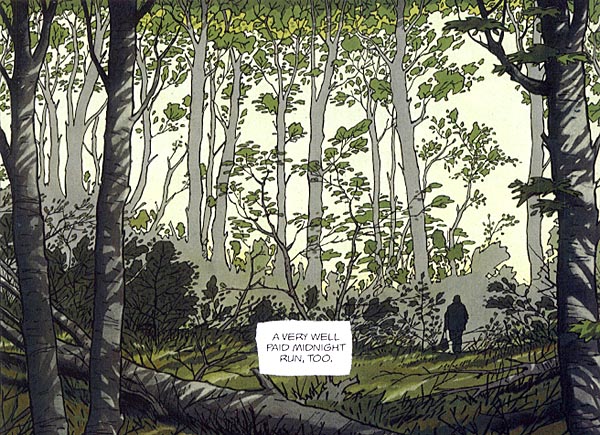 Written by Matz
Written by Matz
Art by Luc Jacamon
32 pages, color
Published by Archaia Studios Press
Anti-heroes are a popular character in fiction these days. You know the type—not really a “good” person, but not the villain either. They often operate under their own set of rules and ethics, and in the end bring about the resolution in a way that isn’t necessarily socially acceptable. You cheer them on even as a voice in the back of your head should be saying, “Should I be this gleeful?” Matz and Luc Jacamon’s The Killer seems to take a slightly different tactic. Their main character isn’t an anti-hero at all, he’s a thoroughly bad person. The only thing is, his story is remarkably enthralling.
 Do you need someone killed, or merely to “vanish” forever? Look no further, because you’ve found your man. For the right price he’ll find and take care of the quarry, and be an absolute professional about it. He’s patient, he’s methodical, he’s efficient. And ultimately, he doesn’t care why you hired him. Only that you do.
Do you need someone killed, or merely to “vanish” forever? Look no further, because you’ve found your man. For the right price he’ll find and take care of the quarry, and be an absolute professional about it. He’s patient, he’s methodical, he’s efficient. And ultimately, he doesn’t care why you hired him. Only that you do.
What struck me very early on with The Killer is that this is an extremely unapologetic protagonist. He doesn’t complain that he can’t do anything else in life, or that it was a dysfunctional childhood that warped him into the life of an assassin. Instead this is someone who’s very matter-of-fact about what he does for a living, and the fact that he’s strictly in it for the money. When he’s gathered enough up, he already knows where he’s going to retire down in Venezuela, away from the public eye and where no one will wonder how he can afford his new life of luxury. Until then, though, he’s just going to keep killing. In lesser hands, this would easily be a turn-off; he’s not a guy that you would ever want to associate yourself with. Matz’s story (translated by Jacamon from the French) pulls the reader in, though, thanks to both his language as well as his attitude. It’s a chilling, very different tactic than most are used to seeing for a main character. He’s not charming, but neither is he a brute that terrorizes those around him. This is someone who is his job, through and through. As a result he’s intelligent, well-educated, and careful—all assets to his job. But at the same time, right as the reader might be warming to him, Matz reminds us that this is a killer and shows us firsthand what happens to his targets. Looking into the head of a sociopath shouldn’t be this intriguing, and yet that’s exactly what Matz provides.
Jacamon’s art is lovely, a lushly styled creation. Jacamon’s figures are strong, but in many ways it’s the scenes that he draws that are the more intriguing. Nothing is left to chance or the imagination here, with opulent statues and rugs adorning rooms, and careful attention drawn to all the details (just like the protagonist is with his assignments). As I looked at more and more of the art from The Killer, I found myself continually impressed with how the entire package is put together. Line art and color work together in unison; an early scene with the killer walking through the woods works in no small part due to the limited color palette, the decision to have some of the background trees defined by outlines and colors with others in the front getting more detail, and the small solid outline of the character himself. The limited color palette is also used carefully by Jacamon; rather than use it as a strict rule, he treats it as merely another tool to create mood and atmosphere, not afraid to break away from its restrictions when it’s time to visually bring the reader to a different place, either physically or mentally. The sudden burst of purples alongside the omnipresent greens of The Killer when we see the lead character’s dream home, for instance, not only shows us what a different place it is from where he lives in terms of terrain, but it says a lot about the character’s frame of mind, showing this place of retirement to be somewhere much more alive and vibrant than the life he currently lives. It’s an extremely effective storytelling technique, and speaks a lot to Jacamon’s careful construction of the book.

Originally published as a five-album series in French, The Killer makes the shift remarkably well into a ten-issue comic book. The end-point for the first issue (originally halfway through the first album) works quite well, so hopefully future albums will step just as smoothly. This is a nicely solid opening for the series, giving the reader more than enough to want to come back. This isn’t the sort of person you want to cheer on, but his story is gripping none the less. If only all attempts at non-sympathetic main characters were this well-rounded and interesting.
Purchase Links: Amazon.com | Powell’s Books
